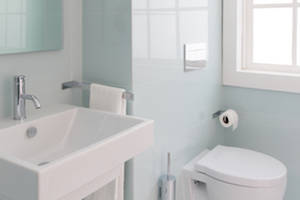 Mold loves bathrooms. They’re small, closed off, and frequently damp – ideal accommodations for mold growth of all kinds. We’ve already taken the time to talk to you about what causes bathroom mold growth as well as how to both remove and prevent it. What we haven’t talked about yet is why it’s so important to do these things. Here are four very good reasons why you shouldn’t let mold grow in your home.
Mold loves bathrooms. They’re small, closed off, and frequently damp – ideal accommodations for mold growth of all kinds. We’ve already taken the time to talk to you about what causes bathroom mold growth as well as how to both remove and prevent it. What we haven’t talked about yet is why it’s so important to do these things. Here are four very good reasons why you shouldn’t let mold grow in your home.
Many common molds are toxic
The three most commonly found varieties of mold found in homes include aspergillus, cladosporium and stachybotrys atra (black mold). Aspergillus is the most common, and very frequently provokes allergic reactions from people and pets. Cladosporium is the least dangerous of the three varieties but may still cause sore throats, watery eyes, and other physical symptoms. Black mold is the most dangerous. When people come into contact with black mold spores they may experience significant health problems. Black mold spores may cause severe allergic reactions or even disease and internal bleeding.
It might affect your mood
A study published by the American Journal of Public Health found that living in a moldy home may negatively affect mental health. In the study, the risk for depression among individuals living in moldy homes averaged 34–44% higher than that of individuals living in mold-free dwellings. Individuals in moldy homes found themselves more likely to feel general malaise, despair, and a lack of energy.
It can lead to many health problems, especially in children.
The most common symptoms of mold exposure include congestion, respiratory problems, coughing, throat irritation, and sneezing. It doesn’t end there, though. Many studies show that infants exposed to mold growth may develop lifelong respiratory symptoms (asthma).
In more extreme cases, mold can lead to infections in the sinuses, lungs, and skin. People with pre-existing respiratory conditions such as asthma are especially at risk of mold-related complications. Long story short: mold exposure will make everyone in your home feel pretty bad, especially kids.
It’s seriously dangerous to pets
Household pets are particularly sensitive to the problems that unchecked mold growth brings about. Pets can suffer from mold poisoning after just minor exposure to mold spore mycotoxins. Symptoms of mold poisoning include respiratory distress, coughing, wheezing, lethargy, vomiting, and bleeding from mucous membranes. If left untreated, mold poisoning symptoms can get worse and lead to more severe problems. In some extreme cases, mold poisoning may prove fatal to household pets.
Luckily, veterinarians can easily treat mold poisoning once you’re aware of the signs. If you see your pet suffering from these symptoms, take them to a vet immediately. Your vet will provide IV fluids and medications that will offset your pet’s autoimmune responses to the mold. If you find out your pet has mold poisoning, make sure you remove the mold quickly and thoroughly.
One of the biggest causes of mold growth in bathrooms are hidden leaks and improper ventilation. The experts at Len The Plumber are more than capable of helping you fix both of these problems. Give us a call today if you suspect that you have some mold-causing issues in your bathroom. We’re happy to do our part to help keep you and your family healthy and comfortable.
The post Why You Need to Prevent Mold Growth in Your Bathroom appeared first on Len The Plumber.
No comments:
Post a Comment